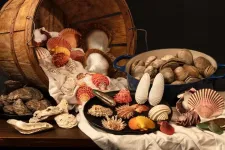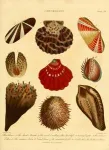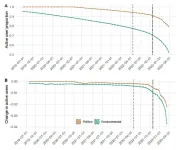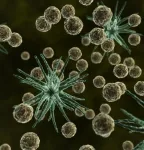(Press-News.org) In a new study, scientists Stewart Edie of the Smithsonian, Shan Huang of the University of Birmingham and colleagues drastically expanded the list of bivalve species, such as clams, oysters, mussels, scallops and their relatives, that humans are known to harvest and identified the traits that make these species prime targets for harvesting. They also discovered that some of these same traits have also made this group of shellfish less prone to extinction in the past and may protect these shellfish in the future. The authors flagged certain ocean regions, such as the east Atlantic and northeast and southeast Pacific, as areas of special concern for management and conservation.
The research, published today in Nature Communications, finds that humans exploit some 801 species of bivalves. That figure adds 720 species to the 81 listed in the Food and Agriculture Organization of the United Nations’ Production Database, calling attention to the huge diversity of shellfish humans are known to harvest and use.
Edie, who serves as the National Museum of Natural History’s curator of fossil bivalves, said that luckily many of the traits that make these bivalve species attractive to humans have also lowered their risk of extinction. Specifically, these species live in a range of climates all over the world, with a wide range of temperatures. This adaptability promotes resilience against natural drivers of extinction. But at the same time, human demand for these species can put them and the ecosystems they are part of at greater risk of destruction.
“We’re fortunate that the species we eat also tend to be more resistant to extinction,” said Edie. “But humans can transform the environment in the geologic blink of an eye, and we have to sustainably manage these species so they are available for generations that will come after us.”
“It is somewhat ironic that some of the traits that make bivalve species less vulnerable to extinction also make them far more attractive as a food source, being larger, and found in shallower waters in a wider geographical area,” said Huang. “The human effect, therefore, can disproportionately remove the strong species. By identifying these species and getting them recognised around the world, responsible fishing can diversify the species that are gathered and avoid making oysters the dodos of the sea.”
Bivalve mollusks such as clams, oysters, scallops and mussels have filtered water and have fed humans for millennia. In places like Estero Bay, Florida, the indigenous Calusa tribe sustainably harvested an estimated 18.6 billion oysters and constructed an entire island and 30-foot high mounds out of their shells.
But the history of humans harvesting bivalves is also rife with examples of overexploitation, largely by European colonizers and mechanized commercial fisheries, that led to collapses of oyster populations in locations including Chesapeake Bay, San Francisco Bay and Botany Bay near Sydney, Australia.
After studying the scientific literature and realizing that there was no comprehensive list of all the species known to be targeted by fisheries, Edie and his co-authors set off to document the array of bivalves utilized by humans.
After collating all the species they found mentioned in more than 100 prior studies, the researchers started investigating possible similarities and patterns among the 801 bivalves on the list. The team examined which traits make a bivalve exploitable by humans and how those traits relate to their risk of extinction.
The study found that humans tend to harvest bivalves that are large-bodied, occur in shallow waters, occupy a wide geographic area and survive in a large range of temperatures. Those final two traits also make most exploited bivalve species less susceptible to the kinds of extinction pressures and risks that have wiped out species from the fossil record in the ancient past.
The researchers hope their data improves conservation and management decisions in the future. Specifically, their list identifies regions and species as being particularly prone to extinction. In a similar vein, the list may help identify species that require further study to assess their current risk of extinction.
Next, Edie said he wants to use the traits associated with exploited bivalves to investigate the bivalve species that are not currently known to be harvested by people.
“We want to use what we learned from this study to identify any bivalves that are being harvested that we don’t already know about,” said Edie. “To manage bivalve populations effectively, we need to have a full picture of what species people are harvesting.”
This research is part of the museum’s Ocean Science Center, which seeks to catalyze change and action by advancing knowledge of the ocean and sharing it with the scientific community, policymakers and the general public. The research also supports the Smithsonian’s Life on a Sustainable Planet initiative, a major effort to collect new data about the changing planet, implement holistic and multi-scale approaches to environmental conservation and educate the world about why and how sustainable solutions to climate change can benefit people and nature.
This research was supported by the Smithsonian, the German Research Foundation, the National Aeronautics and Space Administration and the National Science Foundation.
# # #
END
In October 2022, Elon Musk purchased Twitter (recently renamed X), which had previously served as the leading social media platform for environmental discourse. Since then, reports a team of researchers in the journal Trends in Ecology and Evolution on August 15, there has been a mass exodus of environmental users on the platform—a phenomenon that could have serious implications for public communication surrounding topics like biodiversity, climate change, and natural disaster recovery.
“Twitter has been the dominant social ...
Levels of grey matter in two parts of the brain may be linked to a desire to start smoking during adolescence and the strengthening of nicotine addiction, a new study has shown.
A team of scientists, led by the universities of Cambridge and Warwick in the UK and Fudan University in China, analysed brain imaging and behavioural data of over 800 young people at the ages of 14, 19 and 23.
They found that, on average, teenagers who started smoking by 14 years of age had markedly less grey matter in a section of the left frontal lobe linked to ...
About The Study: In this study, most U.S. infants who required intensive care for respiratory syncytial virus (RSV) lower respiratory tract infections were young, healthy, and born at term. These findings highlight the need for RSV preventive interventions targeting all infants to reduce the burden of severe RSV illness.
Authors: Natasha Halasa, M.D., M.P.H., of the Vanderbilt University Medical Center in Nashville, and Angela P. Campbell, M.D., M.P.H., of the Centers for Disease Control and Prevention in Atlanta, are the corresponding authors.
To access the embargoed study: Visit our For The Media website at this ...
About The Study: In this study of high-use social media platforms, physicians from across the U.S. and representing a range of medical specialties were found to propagate COVID-19 misinformation about vaccines, treatments, and masks on large social media and other online platforms and that many had a wide reach based on number of followers.
Authors: Sarah L. Goff, M.D., Ph.D., of the University of Massachusetts, Amherst, is the corresponding author.
To access the embargoed study: Visit our For ...
Inside all living cells, loosely formed assemblies known as biomolecular condensates perform many critical functions. However, it is not well understood how proteins and other biomolecules come together to form these assemblies within cells.
MIT biologists have now discovered that a single scaffolding protein is responsible for the formation of one of these condensates, which forms within a cell organelle called the nucleolus. Without this protein, known as TCOF1, this condensate cannot form.
The findings could help to ...
The Lundquist Institute (TLI) at Harbor-UCLA Medical Center announced today that TLI Principal Investigator, Michael Yeaman, PhD, has been awarded a grant totaling $11.5M from the National Institute of Allergy and Infectious Diseases (NIAID), Department of Health & Human Services. Along with his role at TLI, Dr. Yeaman is Professor of Medicine at UCLA, and Chief, Division of Molecular Medicine at Harbor-UCLA Medical Center.
This new NIH U19 Center program will decode patterns of the human immune system and microbial pathogens that result in infections that are not ...
Most infants admitted to the intensive care or high acuity unit for respiratory syncytial virus (RSV) infections during fall 2022 were previously healthy and born at term, according to a new study reported in JAMA Network Open.
The findings from this study support the use of preventative interventions in all infants to protect them from RSV, the leading cause of lower respiratory tract infections (LRTI) and hospitalizations worldwide.
RSV accounts for about 57,000-80,000 hospitalizations in children younger than 5 years with 1 in 5 RSV-positive hospitalized children being admitted ...
CLEVELAND–Life’s random rhythms surround us–from the hypnotic, synchronized blinking of fireflies…to the back-and-forth motion of a child’s swing… to slight variations in the otherwise steady lub-dub of the human heart.
But truly understanding those rhythms—called stochastic, or random, oscillations—has eluded scientists. While researchers and clinicians have some success in parsing brain waves and heartbeats, they’ve been unable to compare or catalogue an untold number of variations and sources.
Gaining such insight into the underlying ...
East Hanover, NJ. August 15, 2023. A team of New Jersey researchers reviewed the evidence for the impact of robotic exoskeleton devices on recovery of ambulation among individua5ls with acquired brain injury, laying out a systematic framework for the evaluation of such devices that is needed for rigorous research studies. The open access article, "Lower extremity robotic exoskeleton devices for overground ambulation recovery in acquired brain injury – A review” (doi: 10.3389/fnbot.2023/1014616), was published ...
We have all felt the workings of the so called “brain-gut-axis”, how our intestines get affected, for example, by stress. But still, researchers don’t know a lot about the relation between our gut and our brain.
Research has identified genetic correlations between patients suffering from irritable bowel syndrome (IBS) and psychiatric disorders, such as bipolar disorder.
By using new statistical methods, developed at NORMENT Centre, Post Doctor Markos Tesfaye at the University of Bergen and University of Oslo and his colleagues working under the leadership ...








